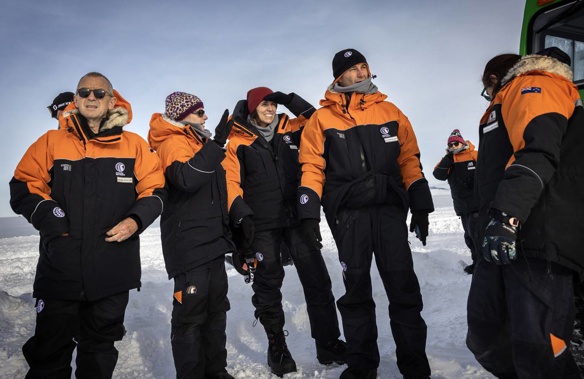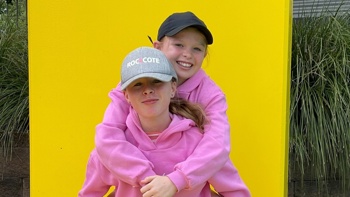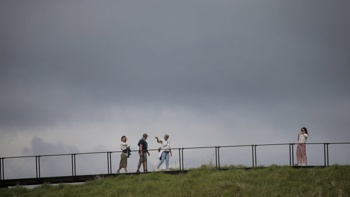
Prime Minister Jacinda Ardern has defended bringing partner Clarke Gayford with her on a trip to Antarctica despite there being limited spaces due to the redevelopment work at Scott Base.
Ardern said with beds at a premium at the base they were “sharing a bunk”, and Gayford’s presence was not displacing any “scientist, researcher or anyone who was part of the redevelopment work”.
Ardern said in the past other prime ministers had also brought their spouses - in 2013 John Key took his wife Bronagh, and in 2007 Helen Clark travelled with husband Peter Davis.
Ardern touched down in Antarctica on Wednesday afternoon aboard a United States Air Force C-17 Globemaster, which is the biggest aircraft to fly from Christchurch.
It came after an aborted first attempt on Tuesday when the NZ Defence Force C-130H Hercules had to return due to poor weather in McMurdo Sound.
Ardern, an avid Antarctic history buff with explorer Ernest Shackleton as one of her personal heroes, said it was a “real honour and a privilege” to be there on her first visit, “five years in the making”.
While an Opposition MP in 2017 Ardern was scheduled to make a trip down but had to cancel when the Mt Albert byelection was announced.
/cloudfront-ap-southeast-2.images.arcpublishing.com/nzme/WGIQQZ7DRVS6A2OV2DJIRJSNXY.jpg) Scott Base in Antarctica, which is undergoing a nearly $350 million redevelopment. Photo / Supplied
Scott Base in Antarctica, which is undergoing a nearly $350 million redevelopment. Photo / Supplied
Ardern said this year’s visit coincided with the 65th anniversary of Scott Base and came at a “critical juncture” of the country’s presence there.
The Government has committed nearly $350 million to redevelop the base and Ross Island wind farm, expected to be finished in 2028, which Ardern said was to predominantly support the “incredibly important” work of scientists there.
The current base, built in the early 1980s and made up of 12 buildings will be replaced with three connected buildings, accommodating up to 100 people.
The new base, built in the same location, will have an accommodation, dining and welfare building, a science and management building and an engineering and storage building.
“It’s a significant project, it’s going to take a number of years, it will create hundreds of jobs actually within New Zealand, because of the way that it’s been constructed,” Ardern said.
“It is a project that has a high dollar value on it. But when you think about the importance of the research that is helping us to make sure that we have a planet we can inhabit in the future, what price do you put on that?”
New Zealand is one of seven nations with territorial claims on Antarctica alongside Australia, France, Norway, the United Kingdom, Chile, and Argentina. Other countries also maintain bases and facilities there, and along with New Zealand are seeking to expand their presence, including China which is building its fifth research station.
/cloudfront-ap-southeast-2.images.arcpublishing.com/nzme/NY6N5COPKREOUYZSCWYYRQTA2Y.jpg) Prime Minister Jacinda Ardern and fiancé Clarke Gayford aboard the RNZAF C130 bound for Antarctica, which had to turn back on Tuesday. Photo / Mike Scott
Prime Minister Jacinda Ardern and fiancé Clarke Gayford aboard the RNZAF C130 bound for Antarctica, which had to turn back on Tuesday. Photo / Mike Scott
Co-operation among the Antarctic Treaty Parties, particularly the United States, New Zealand’s Antarctic neighbour and partner at McMurdo Station for more than 60 years, would also be a focus of Ardern’s trip.
Ardern said another important aspect of her trip was to see firsthand the work of New Zealand scientists.
“The activity that is undertaken down here is so relevant to us right now, particularly the climate work.
“The funding that has gone into climate-based research here formed the basis of the world’s two-degree target or limit for climate change.
“Other scientists focus on the spread of avian illness. Others specialise in volcanic activity and learning from the volcanic activity so that we can know and understand better some of the hazards that we live with every day.
“We collaborate a lot with other countries and our work down here. But in many cases, New Zealand does play a really strong foundation role, particularly the climate-based research.”
As Associate Minister for Arts, Culture and Heritage, Arden said she was also responsible for the Antarctic Heritage Trust and preserving and caring for artifacts from Antarctic explorers, including huts.
She said while few people were able to physically visit them, they were already using virtual reality to “bring to life” huts, including Sir Edmund Hillary’s, in schools. There were also plans to do the same for Ernest Shackleton’s hut.
Ardern said her partner Gayford had visited Antarctica about 15 years ago.
Take your Radio, Podcasts and Music with you









